The Early Returns: We and the Penguins
CAPE ROYDS, ROSS ISLAND, ANTARCTICA– This season, Jean came down to McMurdo Station a few weeks early with the idea of setting up a time-lapse camera at Cape Royds to record the complete cycle of colony formation as penguins returned from their wintering area. She’d keep the camera in place the whole season to show how numbers change during the penguins’ breeding season. The penguins, though, began to arrive earlier than expected, thus she didn’t set up her camera until several had already made their nests!! Our solar powered PenguinCam captured the first arrivals on Oct 20, a full week earlier than last year (you can see the PenguinCam and the images on our website, updated daily, at www.penguinscience.com).
During the first few weeks, we had to drive out to Cape Royds from McMurdo on snowmobiles every few days. This was because the folks at McMurdo were way backed up in being able to install solar power at our camp. Thus, we couldn’t set up a permanent camp. It’s a 35 km trip from McMurdo, taking about 40 minutes. We had to drive out in order to look for banded penguins, whether they laid eggs, and to change the batteries in the time-lapse cameras. Here we are on one of the trips; for safety two snowmobiles were required…we took along people from McMurdo so that they could get a chance to see Antarctica:

It is a 40 min drive from McMurdo Station to Cape Royds on snow machines. Here we take a break to watch the plume on Mt Erebus, the only active volcano in Antarctica.
The reason the penguins arrived early, is that with a lack of wind during the winter (that’s true, it wasn’t very windy), the large-scale extent of sea ice in this portion of the Southern Ocean was much less than usual. The penguins winter at the pack ice edge, so with the edge much closer to Ross Island, they had a much shorter, maybe 1000 km less, trip to make.
The situation with the ice patterns involves the wind rather than temperatures. The temperatures are cold, regardless. When the winds blow off the continent in the winter the ice is blown farther and farther northward (away from the continent) leaving open water at the coast which allows more ice to be formed, which then gets blown north and the cycle goes on continuously (in most winters-springs). It’s like a conveyor belt. Winters with continuous winds, which is the usual, create pack ice a long way from the land sometimes as far as 2000 km. This last winter the winds were not strong or persistent and not as much ice was blown away from the continent. Thus, the penguins were not very far away when the sun rose and they began their southward journey. Not having as much distance to cover during spring migration, they arrived earlier than usual.
Once the first penguins arrived, the ‘flood’ began. Throughout the following few weeks, birds continued to come ashore, build their nests, find their mates and on Nov 5th we saw the first egg.
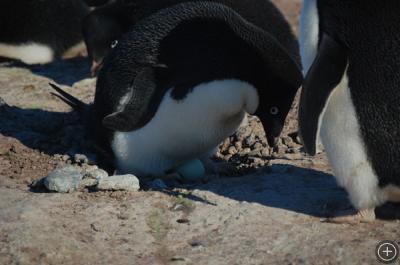
The first egg of the 2008-09 Adélie Penguin breeding season at Cape Royds, a bit early this year Nov 5.
Here’s a graph of penguin counts from the PenguinCam, comparing this year with last (the spaces between counts were days when it was too windy or snowy to get a clear image…many more of these windy days in 2007):
The window of successful laying at Cape Royds is short. If the eggs are not laid by about now (24 Nov), it is unlikely that parents can be successful. That’s because the winter comes early! A major factor that will contribute to the success rate of this year’s colony is the distance the birds will have to walk to find open water and food. After the female lays her eggs, she leaves the male in charge of the nest and returns to the sea to forage. This year, because of the lack of wind, a very extensive continuous sheet of ‘fast ice’ was able to form. Normally, wind would have blown new ice away, but the wind didn’t happen, so the ice sat in place and got so thick that whatever the strength of the later wind, it was not strong enough to budge the ice. It was locked fast in place by various points of land (kind of like a jig-saw puzzle). Now it is a long way from Cape Royds to the ocean and food, 70 km. This means two days of just walking, one way. Many females may decide not to return to relieve their mates, or will return a few days too late. The males will not sacrifice themselves for the sake of the egg, the drive to satisfy their growing hunger outweighing the inclination to raise progeny, and if the females do not return they will abandon the eggs. Only time will give us the answer to this one, but it is likely that the ice will remain in place until January, when the icebreaker arrives.
Here is an image taken by a NASA satellite a few days ago. It shows where Royds is located, and where the edge of the fast ice occurs (out by Beaufort Island). So, the penguins at Royds have to add 4 days to a foraging trip, 2 for walking out and 2 for walking back. Added to that are the days needed to catch food and replace fat reserves, i.e. several days. Four days of walking is a long time when you are hungry.


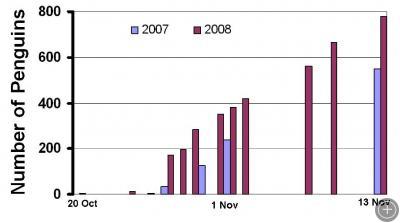
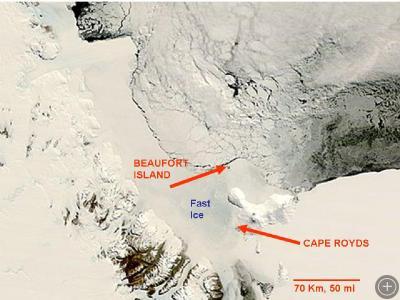

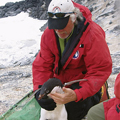

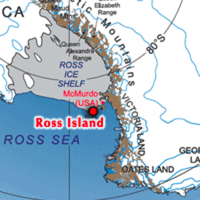





I LOVE THE PUNGIN GIVING BIRTH